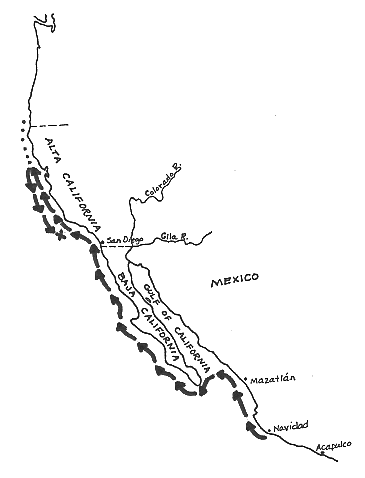| ||||
|
| ||||
|
JUAN
RODRIGUEZ CABRILLO
 Lived:
about 1500-1543
Lived:
about 1500-1543
Explored California in: 1542
Exploring for: Spain
Explored: by sea on the California coast as far as the Oregon border
Juan Rodríguez Cabrillo is often named as the “discoverer” of California. Though history shows that several other explorers (Alarcón, Díaz) were actually in California a few years earlier, Cabrillo gets credit for being the first European to explore the California coast.
EARLY HISTORY
Neither Cabrillo’s name nor country of birth is known with certainty. It is possible that his true name was Juan Rodríguez and that “Cabrillo,” which means “little goat,” was a nickname or referred to his home town. He signed papers as “Juan Rodz,” which indicates a Spanish spelling. However, early historians said that he was Portuguese.
Whatever his name and origin,
Cabrillo left Europe sometime after 1510 and landed in
Cabrillo also took part in the
conquest of
BACKGROUND
When Alvarado died in 1541, Antonio
de Mendoza, the viceroy (governor) of New Spain (
CABRILLO’S JOURNEY
Cabrillo had three ships in his command, none of them very well built. Besides the San Salvador, a 100-foot galleon, there was the frigate Victoria, commanded by pilot Bartolomé Ferrer (sometimes spelled Ferrelo), and the San Miguel, a small launch commanded by Antonio Correa. The crews of these three vessels numbered about 200 men, many of them forced into service. The San Salvador was armed with cannon.
Cabrillo left the port of Navidad
in
Landing in Alta (Upper) California
On September 28, after three
months of sailing, Cabrillo brought his ships into a bay which he called a
“very good enclosed port.” He named it San Miguel, and claimed the land for
The ships then continued on up the coast of California, stopping at islands now called Santa Catalina and San Clemente, and passing the Santa Barbara Channel Islands. Along the way they saw and talked with many Indians. They noted the streamers of smoke from Indian campfires along San Pedro and Santa Monica bays. They admired the plank canoes of the Chumash Indians near present-day Oxnard. Cabrillo always made friendly gestures toward the Indians and avoided any fighting.
Forced back by strong winds at Point Conception, the ships anchored at one of the Channel Islands now called San Miguel. During the week they stayed there, Cabrillo apparently fell and broke his arm. However, as soon as the weather allowed, he continued on to the north.
On November 16 the three ships anchored in Monterey Bay. They may well have gone further north, perhaps as far as Point Reyes, but they did not see the entrance to San Francisco Bay. The seas were very stormy and the ships were taking a hard beating. Cabrillo decided to turn south again and they reached San Miguel Island on November 23.
Cabrillo’s Death
Cabrillo died on this island on January 3, 1543. One story says it was a result of his broken arm in October. Others say that he slipped on a rock in December and shattered his shinbone. He then became very ill and died. Reports say that he was buried on San Miguel Island, but the site of his grave is not known.
Before he died, Cabrillo appointed Bartolomé Ferrer as captain of the expedition, and directed him to continue exploration of the northern coast.
On February 18, 1543, Ferrer started north again. The weather was still bad, and somewhere off the northern California coast, about the first of March, the ships became separated. Fearing to perish against the rocky coast, short of food, and with many of the crew sick from scurvy, each ship headed south. They met again far down the coast of Baja California, and sailed on together to the port of Navidad, arriving on April 14, 1543.
WHAT HE ACCOMPLISHED
Cabrillo was the first to chart the coastline of California. He was the first to bring back to New Spain reports of the various Indian groups living along the coast. And he officially claimed the land for Spain.
Cabrillo National Monument on Point Loma in San Diego commemorates the exploration of Juan Rodríguez Cabrillo with a 14-foot sandstone statue completed in 1939. Point Cabrillo in Mendocino County is named for him, as is Cabrillo Point in Monterey County.